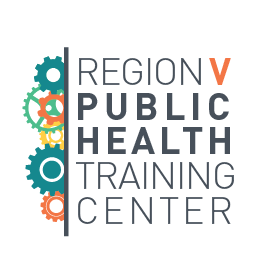From left to right: Cecie Culp, Wisconsin Department of Health Services; Margarita Northrup, Wisconsin Department of Health Services; Rabbi Bonnie Margulis, Wisconsin Faith Voices for Justice; Angela Acker, UW Population Health Institute
By Annie Rosemurgy, Jed Amurao, and Angela Acker, University of Wisconsin Population Health Institute
Narrative change is gaining recognition as a fundamental tool of public health practice. During the COVID-19 pandemic, public health professionals and community residents were reminded that our values as individuals and as a collective profoundly impact health outcomes for all.
Narratives are “the values-based themes of stories that we use to understand our world” (adapted from Grassroots Power Project).
Narratives are communicated through messages that reflect deep cultural values and worldviews that we hold in our minds and that we externalize through our actions and the stories we tell. Often we operate based on narratives without being consciously aware of them, but narratives set boundaries of what is possible and what is common sense.
As such, narratives have the capacity to either support or inhibit structural change for health equity and racial justice. Narratives can be conduits for misinformation and disinformation. The promotion of narratives that reflect values for health and equity can accelerate us towards a world where people and places all thrive.
At the University of Wisconsin Population Health Institute (UWPHI) we recognize that although harmful narratives can threaten public health, these narratives were built by people and can be changed by people. Narratives can be transformed to support health and equity and elevate shared values reflective of health, equity, and social solidarity. Here are two programs at UWPHI that have been working on this:
County Health Rankings & Roadmaps and Human Impact Partners co-lead Narratives for Health, a project based on the belief that public health practitioners need to contend for power to shift narratives. Alongside many partners and supporters from across the country, the project elevates a transformative narrative for health and equity by offering:
- Narrative discussions and facilitator trainings. The project provides learning opportunities, from orientation-level materials and discussions to facilitated narrative cohorts and a train-the-facilitator series for public health and health care practitioners across the nation. This includes practice-related materials around narrative, power, and the narrative process. These discussions and trainings help identify ways for people to apply narrative to their work, within their organization and within their network.
- Post-cohort action and support. After engaging in narrative discussions, participants can join other narrative builders for a monthly Community of Practice. Narratives for Health offers support and small funding opportunities as organizations identify ways to apply narrative strategy to their work. Narratives for Health recently launched Action Groups for people and organizations to rally around key topics and identify ways to apply transformative narratives collectively.
- Evaluation and research. Narratives for Health is developing case examples and lessons learned on ways to apply and diffuse transformative narratives in public health and what it means to build a health equity narrative infrastructure.
Through The Centers for Disease Control and Prevention’s Public Health Infrastructure Grant (PHIG) dollars awarded to Wisconsin, efforts to equip partners throughout the state with methods for narrative change are now underway. A key component of UWPHI’s 2024 PHIG work is a variety of programming aimed at making narrative work more accessible and applicable for local and tribal health departments, and other allied organizations, in Wisconsin.
UWPHI’s PHIG team presented a series of online learning events called Immersions. The first Immersion introduced participants to transformative narrative and asked them to examine the role narrative has played in their own lives. The second Immersion delved deeper into narrative skill-building with an exercise where participants examined what values and narratives are embedded within the Public Health Accreditation Board Foundational Public Health Services and Foundational Capabilities framework. The third Immersion focused on actionable skills to navigate difficult conversations in public health. Facilitated discussion sessions around narrative application will continue.
Although two distinct programs, we know that we are stronger together. As UWPHI grounds our narrative strategy in collective learning, dialogue, and implementation, we know that narrative change occurs through both external and internal mindset shifts. Internally, our organizational strategic plan prioritizes narrative and creates an infrastructure to support narrative change. We embed transformative narratives within our tools and resources and create spaces to share best practices, like our internal Health Equity Community of Practice and formal and informal working groups, to collaborate across programs. We continue to modify our systems and processes to stay in alignment with best practices and to ensure that our work is rooted in transparency, equity, and social solidarity.
Narrative change is long-term work that requires commitment, fortitude, and hope. Our organization continues to integrate and diffuse narrative strategy internally and externally so that, together, we ensure that health equity and racial justice become a reality.
To learn more about narrative, go to Narratives for Health or join the waitlist to be the first to learn when the next Narratives for Health Train-the-Facilitator series is open for registration. Participants will engage in a series of three sessions to: 1) introduce narrative strategy for health equity; 2) discuss shared values and beliefs, narrative concepts, dominant narratives vs. transformative narratives, and narrative power; and 3) model and debrief the narrative development process and ways to apply narrative strategy.
To learn more, check out these resources:
- Narratives for Health
- Join the waitlist to be the first to learn when the next Narratives for Health Train-the-Facilitator series is open for registration. Participants will engage in a series of three sessions to: 1) introduce narrative strategy for health equity; 2) discuss shared values and beliefs, narrative concepts, dominant narratives vs. transformative narratives, and narrative power; and 3) model and debrief the narrative development process and ways to apply narrative strategy.
- Immersion resources page
- Knowledge, Narratives, and Numbers: Strategic Storytelling as a Foundation toward Transformation self-paced training

